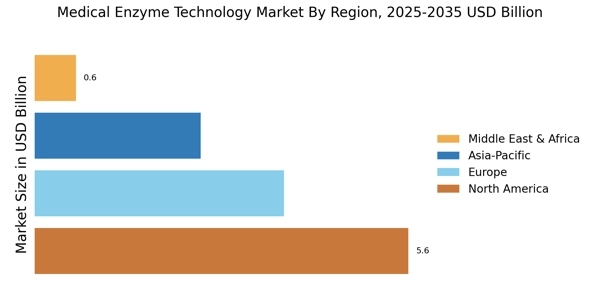Rising Awareness of Enzyme Therapies
There is a notable increase in awareness regarding the benefits of enzyme therapies among healthcare providers and patients, which is driving the Medical Enzyme Technology Market. Educational initiatives and outreach programs are playing a crucial role in disseminating information about the efficacy of enzyme-based treatments. As healthcare professionals become more informed about the advantages of these therapies, they are more likely to recommend them to patients. This growing awareness is reflected in the increasing adoption rates of enzyme therapies, particularly in the treatment of rare diseases and metabolic disorders. Consequently, the Medical Enzyme Technology Market is poised for growth as more individuals seek out these innovative treatment options.
Increasing Prevalence of Chronic Diseases
The rising incidence of chronic diseases such as diabetes, cancer, and cardiovascular disorders is a pivotal driver for the Medical Enzyme Technology Market. As these conditions become more prevalent, the demand for innovative therapeutic solutions, including enzyme-based treatments, is likely to surge. Enzymes play a crucial role in metabolic processes, and their application in disease management is gaining traction. For instance, the market for enzyme replacement therapies is projected to expand significantly, with estimates suggesting a compound annual growth rate of over 8% in the coming years. This trend indicates a growing recognition of the therapeutic potential of enzymes, thereby propelling the Medical Enzyme Technology Market forward.
Regulatory Support for Enzyme-Based Therapies
Regulatory bodies are increasingly recognizing the therapeutic potential of enzymes, which is fostering growth in the Medical Enzyme Technology Market. The establishment of clear guidelines for the approval of enzyme-based therapies is encouraging pharmaceutical companies to invest in this area. Regulatory support not only streamlines the approval process but also enhances the credibility of enzyme therapies among healthcare professionals and patients. As more enzyme-based products receive regulatory approval, the market is likely to expand, with a growing number of treatment options becoming available. This trend indicates a positive outlook for the Medical Enzyme Technology Market, as it aligns with the broader movement towards innovative and effective healthcare solutions.
Growing Investment in Research and Development
Investment in research and development (R&D) within the Medical Enzyme Technology Market is on the rise, driven by the need for innovative therapeutic solutions. Pharmaceutical companies and research institutions are increasingly allocating resources to explore the potential of enzymes in drug development and disease treatment. This trend is evidenced by the substantial funding directed towards enzyme-related research, which has seen a marked increase in recent years. The focus on developing targeted therapies and personalized medicine is likely to further stimulate R&D activities, leading to breakthroughs in enzyme applications. Consequently, the Medical Enzyme Technology Market stands to benefit from a robust pipeline of new products and therapies.
Technological Advancements in Enzyme Production
Technological innovations in enzyme production are transforming the Medical Enzyme Technology Market. Advances in recombinant DNA technology and fermentation processes have enhanced the efficiency and yield of enzyme production. These developments not only reduce production costs but also improve the purity and efficacy of enzymes used in medical applications. Furthermore, the integration of artificial intelligence and machine learning in enzyme design is expected to streamline the discovery of novel enzymes with specific therapeutic properties. As a result, the Medical Enzyme Technology Market is likely to witness an influx of new products that cater to diverse medical needs, thereby expanding its market reach.


















Leave a Comment